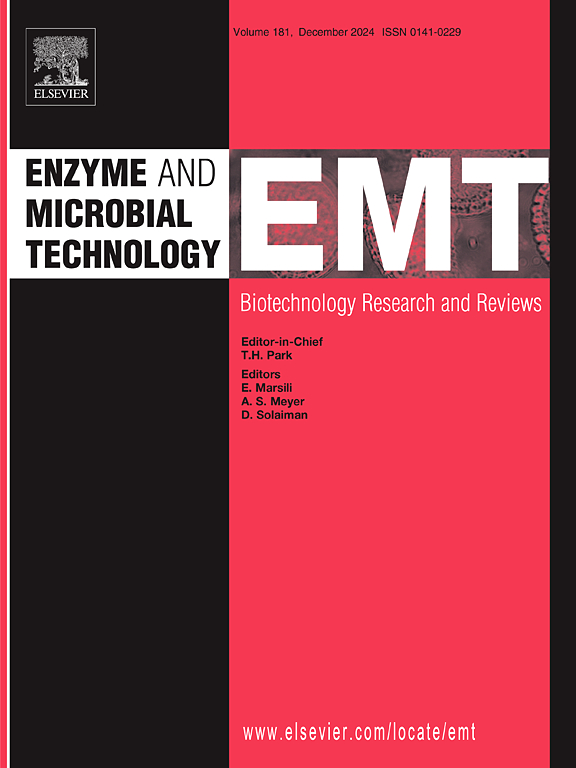Identification of 2’-deoxyguanosine for an α-amylase inhibitor in the extracts of the earthworm Eisenia fetida and characterization of its inhibitory activity against porcine pancreatic α-amylase
IF 3.7
3区 生物学
Q2 BIOTECHNOLOGY & APPLIED MICROBIOLOGY
引用次数: 0
Abstract
Inhibitory activity (IA) against porcine pancreatic α-amylase (PPA) has been found in the water extract of Eisenia fetida. IA is recovered mostly in a fraction (U3EE) containing compounds of low molecular mass under 3 kDa. U3EE is treated with 85 % ethanol (EtOH) and the obtained EtOH extract is applied to the solid-phase extraction (SPE) system. An IA fraction named AI is separated from SPE by elution with water, and then a fraction AI* has been obtained by elution with 5 % EtOH. In the previous study, PPA inhibitors of guanine (Gua), guanosine (Guo), and inosine (Ino) have been isolated from AI. In the present study, IA of AI* was examined and a new inhibitor 2’-deoxyguanosine (2’-dGuo) was isolated by RP-HPLC. It was a mixed-type inhibitor showing IC50 of 0.7 ± 0.1 mM and inhibitor constants Ki and Ki’ of 2.0 ± 0.5 and 0.9 ± 0.2 mM, respectively, at pH 6 and at 37 °C. PPA inhibitors of U3EE were arranged in the order according to the inhibitory efficiency as Gua> 2’-dGuo> Guo> Ino. This study reports that compounds related to nucleic acids could be PPA inhibitors. These inhibitors as well as U3EE might be suitable for functional foods to prevent obesity and type 2 diabetes.
蚯蚓提取物中α-淀粉酶抑制剂2′-脱氧鸟苷的鉴定及其对猪胰腺α-淀粉酶抑制活性的研究
对猪胰α-淀粉酶(PPA)有抑制作用。IA主要在含有3 kDa以下的低分子质量化合物的馏分(U3EE)中回收。U3EE用85% %乙醇(EtOH)处理,得到的EtOH萃取物应用于固相萃取(SPE)系统。在固相萃取中用水洗脱得到IA馏分AI,再用5 % EtOH洗脱得到AI* 馏分。在之前的研究中,已经从AI中分离到鸟嘌呤(Gua)、鸟苷(Guo)和肌苷(Ino)的PPA抑制剂。本研究对AI* 的IA进行了检测,并采用反相高效液相色谱(RP-HPLC)分离了一个新的抑制剂2′-脱氧鸟苷(2′-dGuo)。这是一个混合型缓蚀剂的IC50 0.7 ±0.1 毫米和抑制剂常数Ki和Ki 2.0 ± 0.5和0.9±0.2 mM,分别在pH值6和37 °C。U3EE的PPA抑制剂按照抑制效率顺序排列为:Gua>; 2 ' -dGuo>; Guo>; Ino。本研究报道了与核酸相关的化合物可能是PPA抑制剂。这些抑制剂以及U3EE可能适合用于预防肥胖和2型糖尿病的功能性食品。
本文章由计算机程序翻译,如有差异,请以英文原文为准。
求助全文
约1分钟内获得全文
求助全文
来源期刊

Enzyme and Microbial Technology
生物-生物工程与应用微生物
CiteScore
7.60
自引率
5.90%
发文量
142
审稿时长
38 days
期刊介绍:
Enzyme and Microbial Technology is an international, peer-reviewed journal publishing original research and reviews, of biotechnological significance and novelty, on basic and applied aspects of the science and technology of processes involving the use of enzymes, micro-organisms, animal cells and plant cells.
We especially encourage submissions on:
Biocatalysis and the use of Directed Evolution in Synthetic Biology and Biotechnology
Biotechnological Production of New Bioactive Molecules, Biomaterials, Biopharmaceuticals, and Biofuels
New Imaging Techniques and Biosensors, especially as applicable to Healthcare and Systems Biology
New Biotechnological Approaches in Genomics, Proteomics and Metabolomics
Metabolic Engineering, Biomolecular Engineering and Nanobiotechnology
Manuscripts which report isolation, purification, immobilization or utilization of organisms or enzymes which are already well-described in the literature are not suitable for publication in EMT, unless their primary purpose is to report significant new findings or approaches which are of broad biotechnological importance. Similarly, manuscripts which report optimization studies on well-established processes are inappropriate. EMT does not accept papers dealing with mathematical modeling unless they report significant, new experimental data.
 求助内容:
求助内容: 应助结果提醒方式:
应助结果提醒方式:


